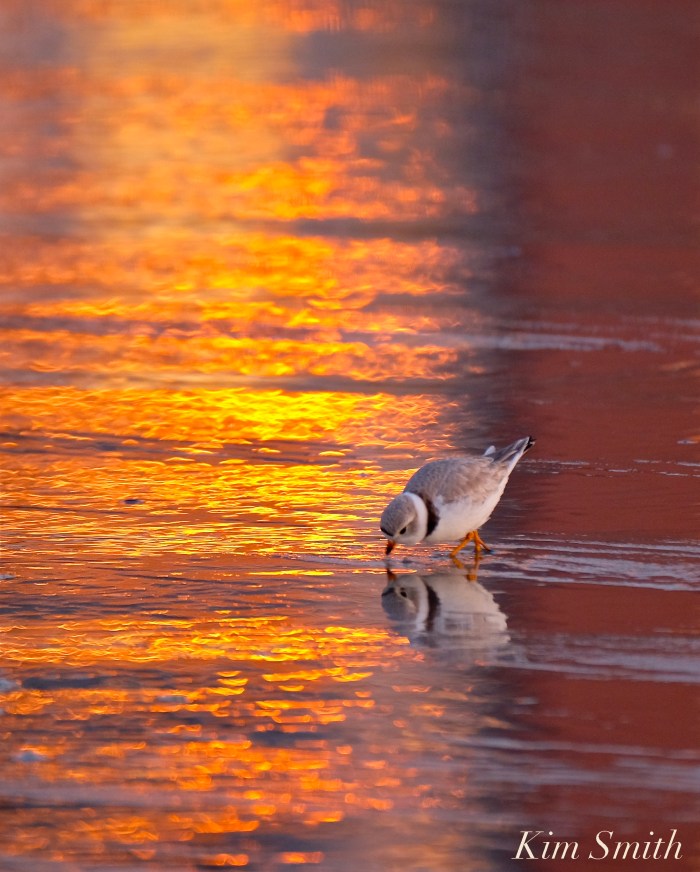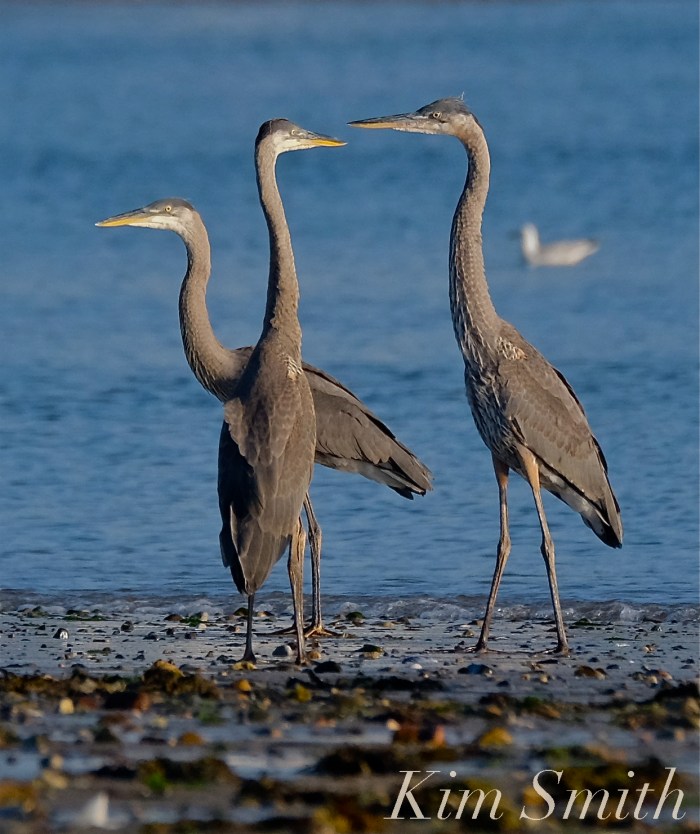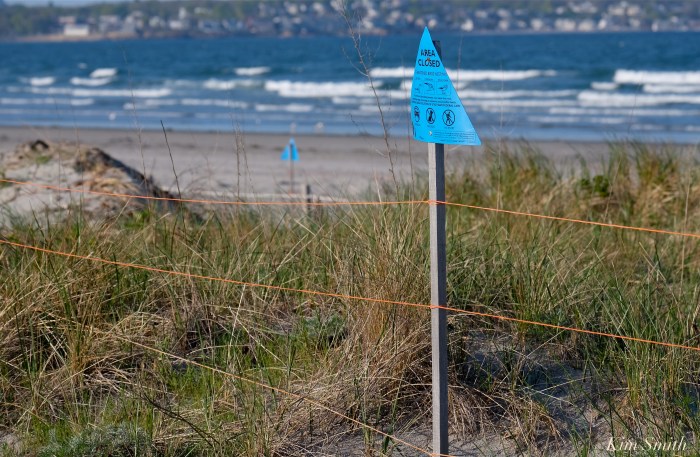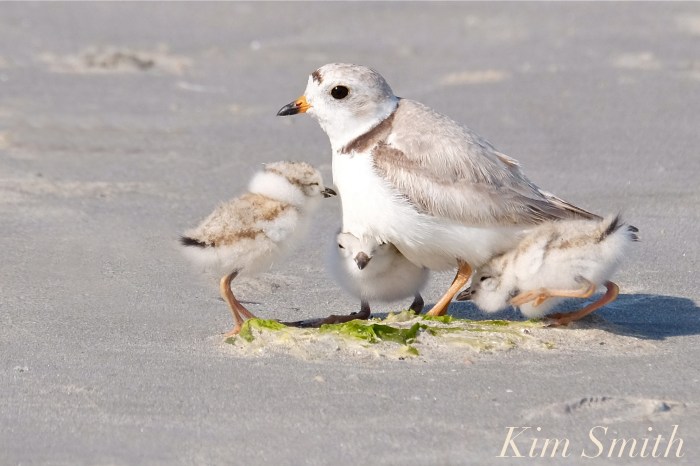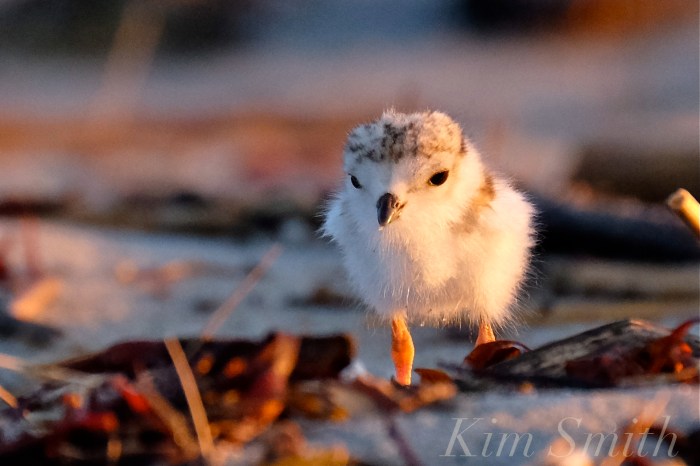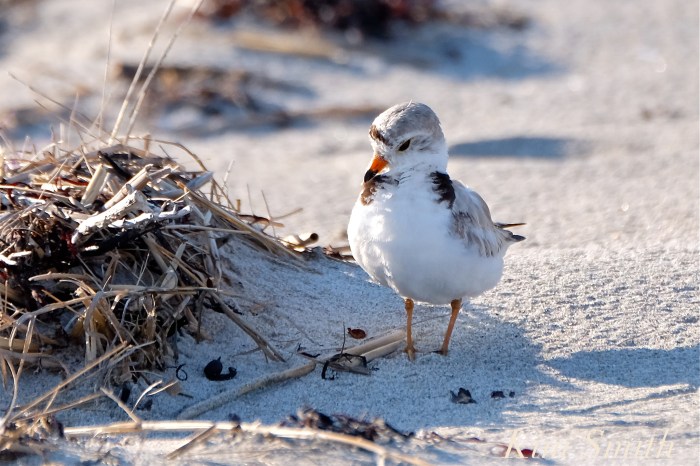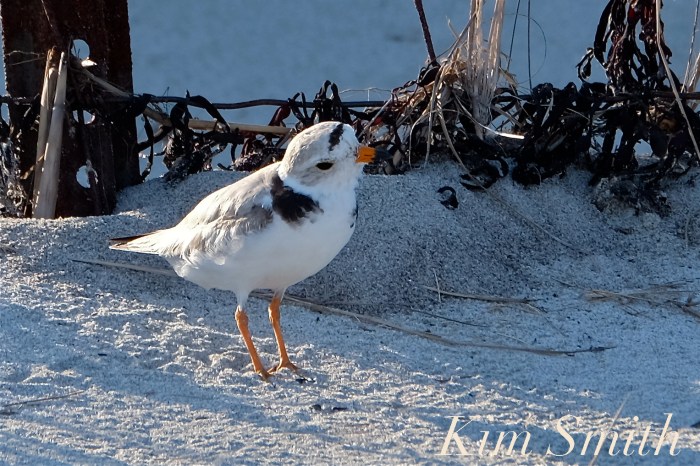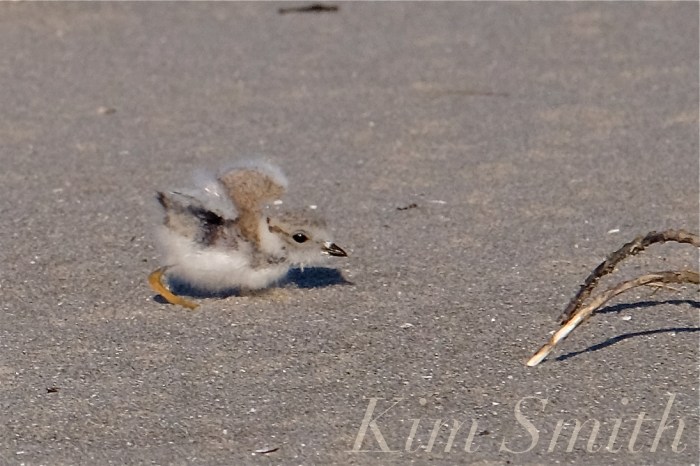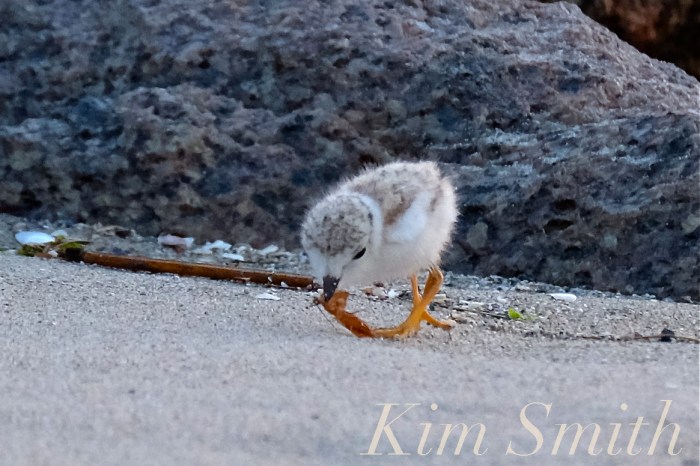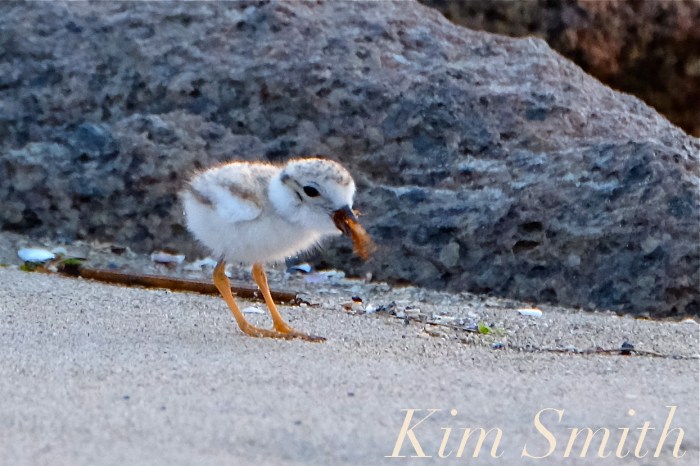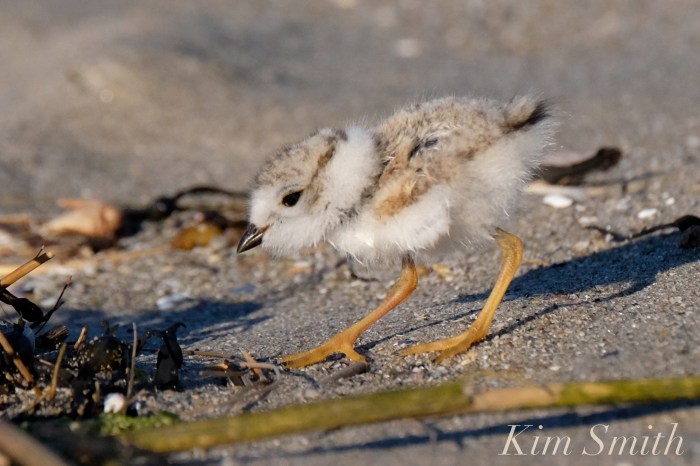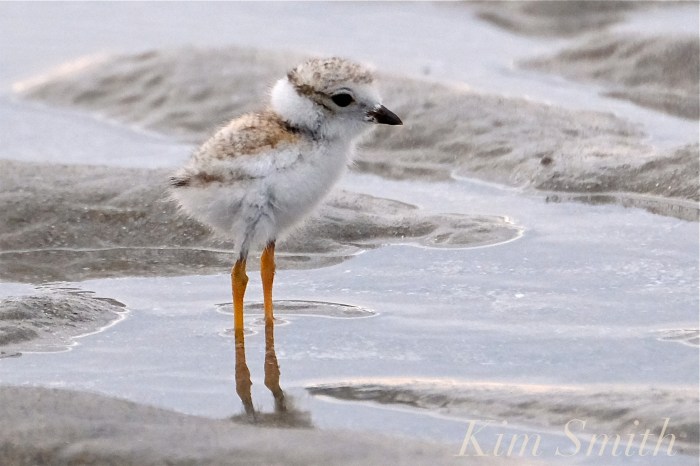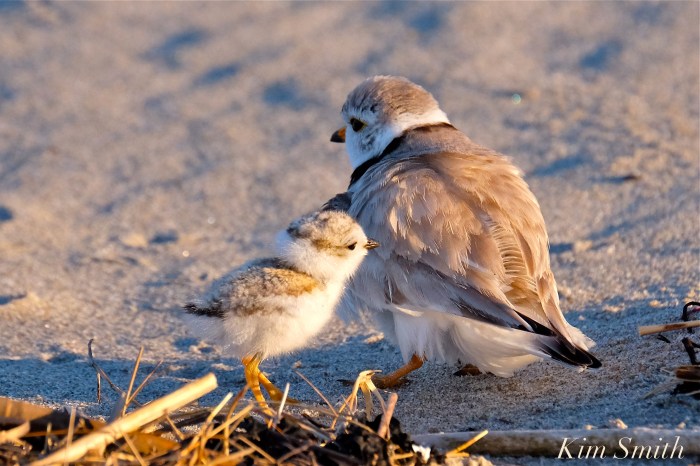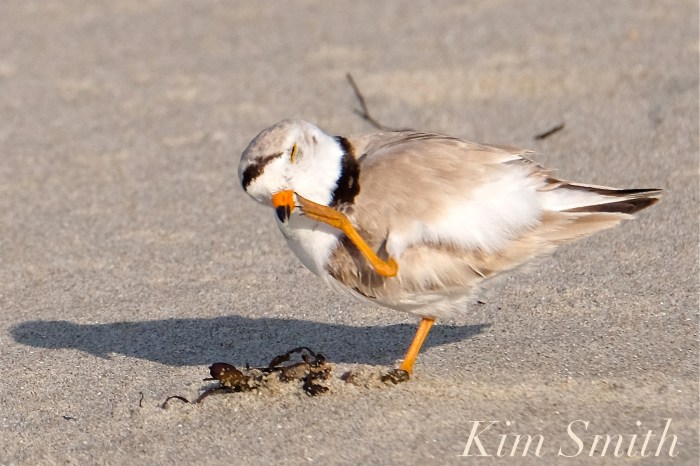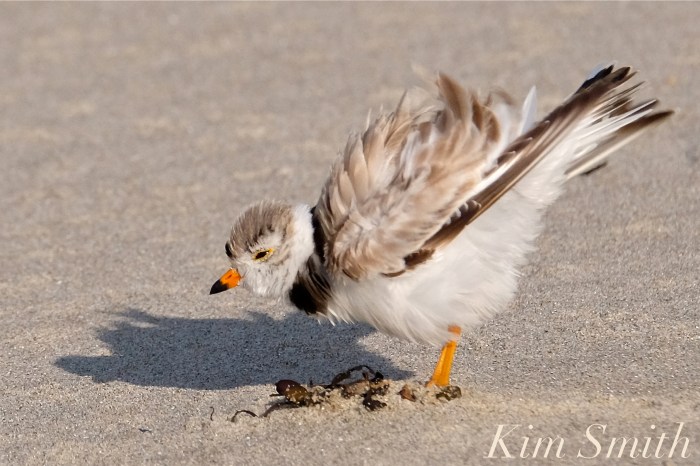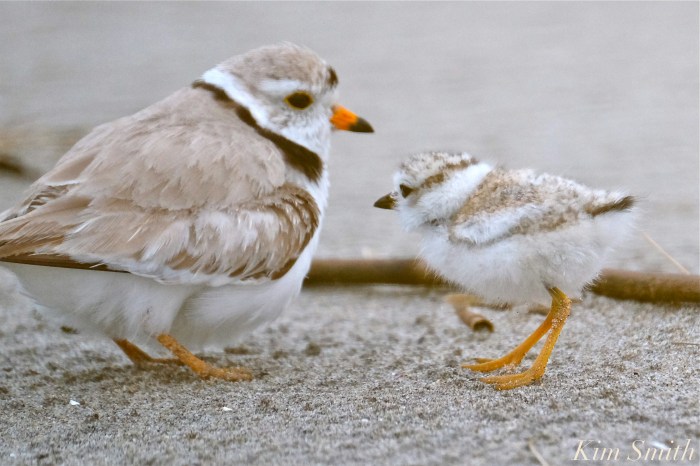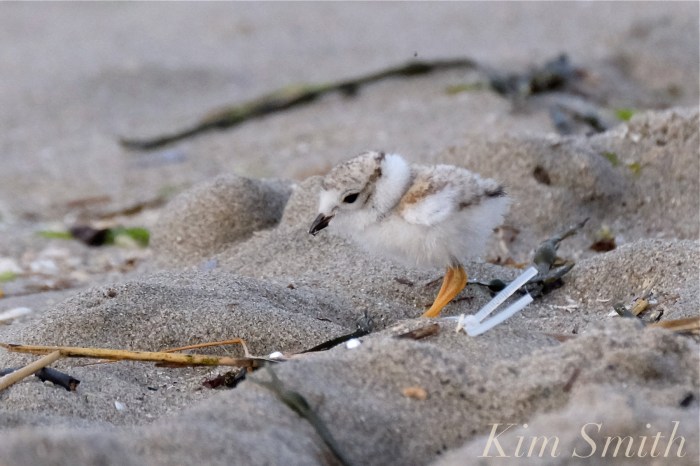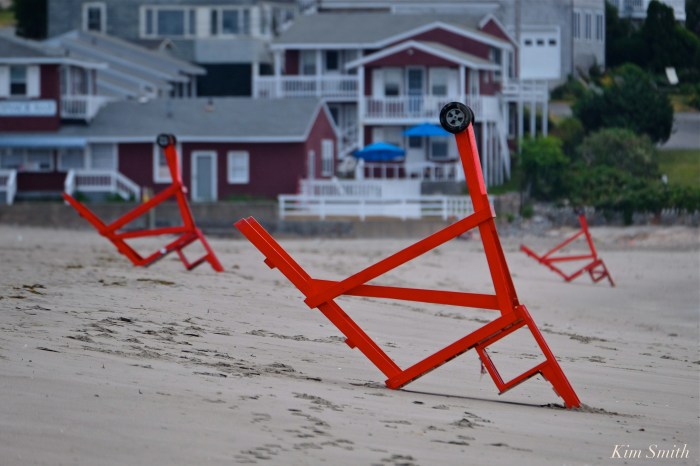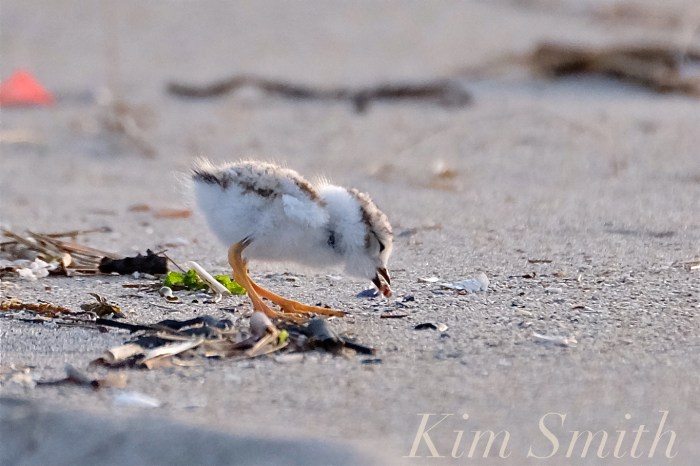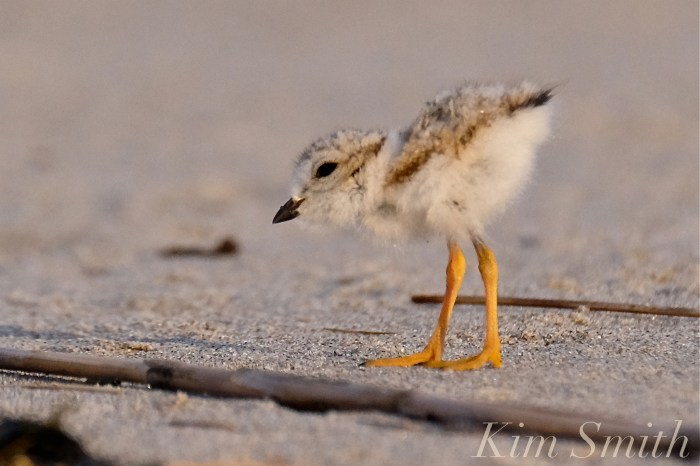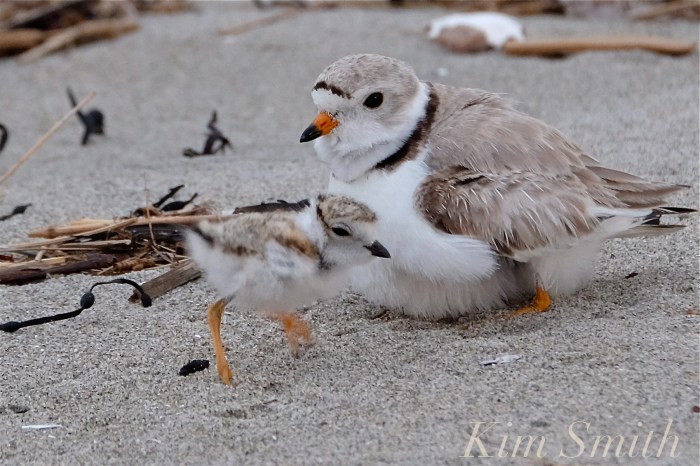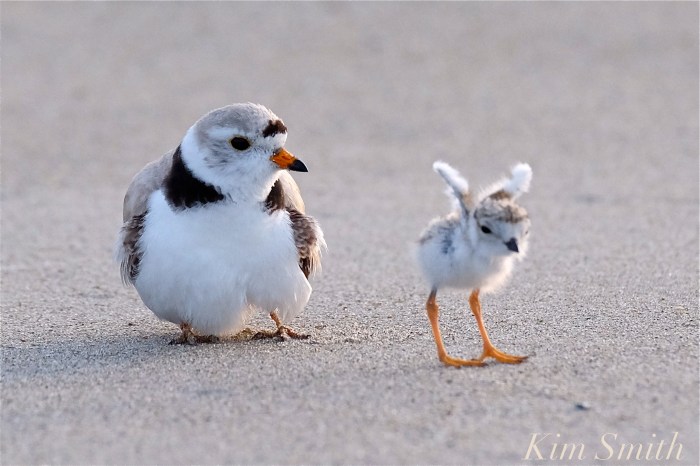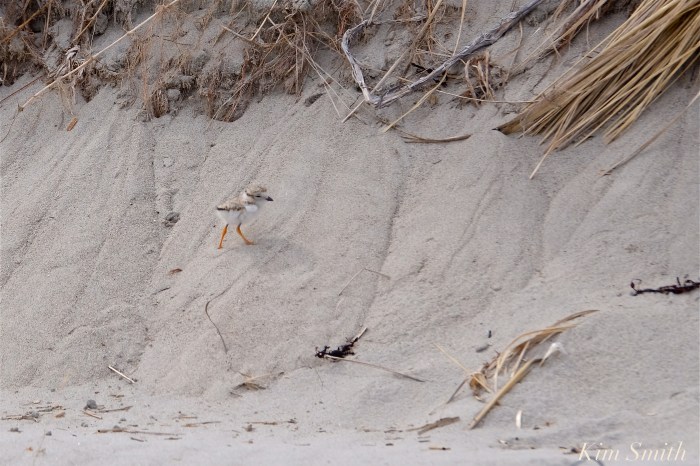PLEASE NOTE THE CHANGE OF MEETING PLACE. THE MEETING WILL BE HELD AT THE FRIEND ROOM AT THE SAWYER FREE LIBRARY
Tag: how you can help the plovers
PIPING PLOVERS ON THE AGENDA: PLEASE NOTE CHANGE OF MEETING LOCATION FOR THE ANIMAL ADVISORY COMMITTEE MEETING THURSDAY NIGHT
Animal Advisory Committee Meeting Thursday, August 23rd, at 6:30. This meeting is being held at the Friend Room at the Sawyer Free Library. 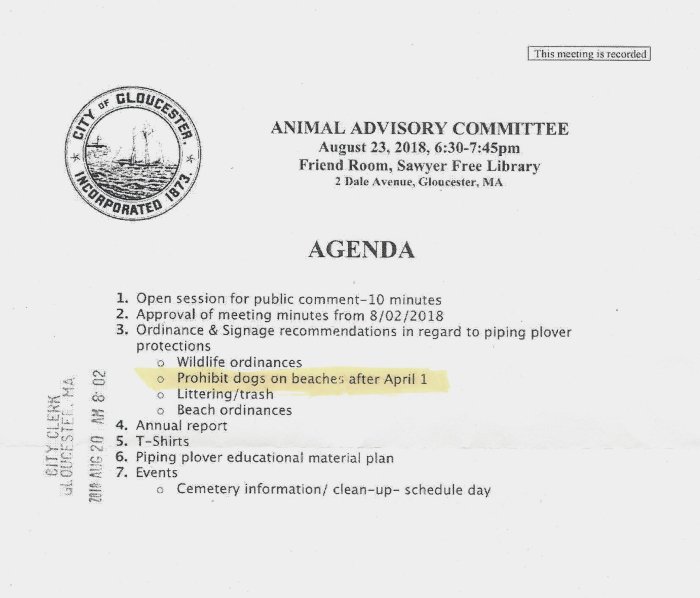
Lest anyone has forgotten, a beautiful pair of Piping Plovers tried to establish a nest on Good Harbor Beach during the month of April. Time and time again, they were disrupted by dogs–dogs off leash on on-leash days, dogs running through the nesting area, and bird dogs chasing the birds up and down the shoreline. This was witnessed multiple times during the month of April by the Piping Plover volunteer monitors.
Piping Plovers face many man made problems and natural predators however, the two greatest threats at Good Harbor Beach are dogs and crows. Changing the ordinance on Good Harbor Beach to help the Piping Plovers will at the very least allow them to nest in their natural environment. Our parking lot nesting pair were extremely stressed having to defend both territories, the parking lot nest and their roped off territory. Please let Mayor Sefatia and city councilors know that you support the change in ordinance to restrict dogs on Good Harbor Beach during the month of April.
Thank you for your help!
The following series of photos shows why it is so critically important to not allow dogs on Good Harbor Beach during shorebird nesting season, which begins April 1st on most Massachusetts beaches.
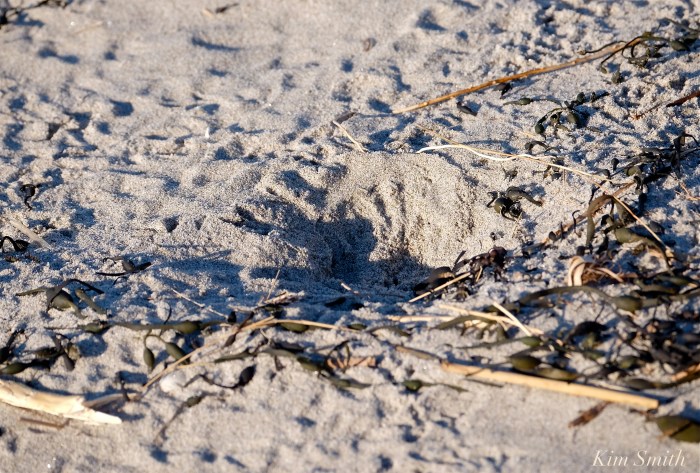 Early April and our returning Good Harbor Beach Dad begins making nest scrapes.
Early April and our returning Good Harbor Beach Dad begins making nest scrapes.
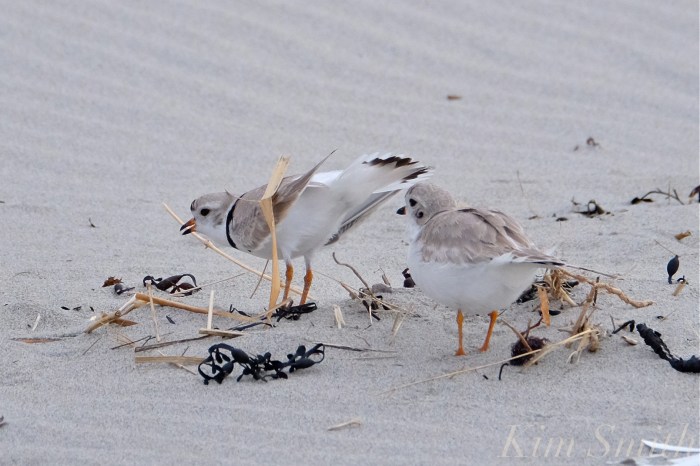 He invites Mom to come inspect.
He invites Mom to come inspect.
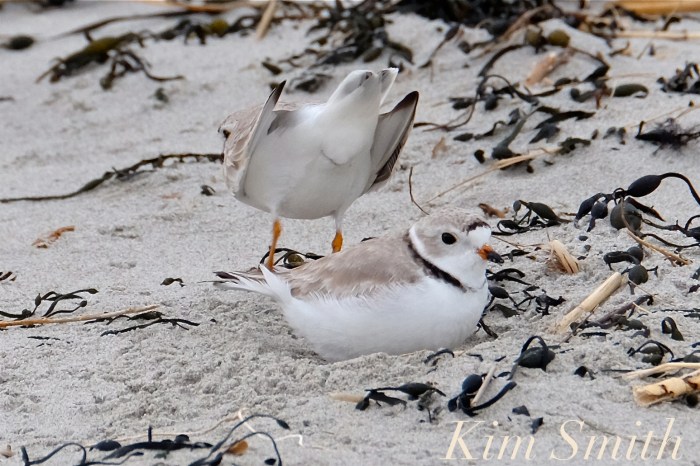 She tries the nest on for size and approves! Mom appears plump and ready to begin laying eggs.
She tries the nest on for size and approves! Mom appears plump and ready to begin laying eggs.
 Mid-April and after days of dogs running through the nesting area, the Piping Plovers are discovered standing on the white lines in the GHB parking lot.
Mid-April and after days of dogs running through the nesting area, the Piping Plovers are discovered standing on the white lines in the GHB parking lot.
 Dad begins making nest scrapes on the painted white lines in the parking lot gravel.
Dad begins making nest scrapes on the painted white lines in the parking lot gravel.
 With fewer cars in the lot during the month of April, the PiPl determine the lot is safer than the beach. They give up trying to nest on the beach and concentrate solely on the parking lot nest.
With fewer cars in the lot during the month of April, the PiPl determine the lot is safer than the beach. They give up trying to nest on the beach and concentrate solely on the parking lot nest.
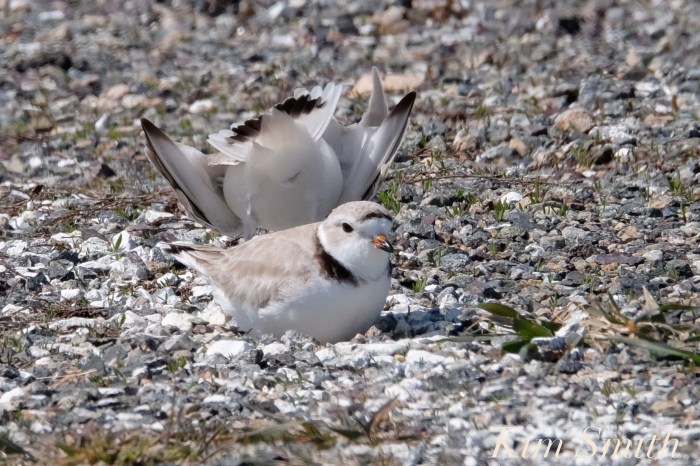 Dad invites Mom to inspect the parking lot nest scrape.
Dad invites Mom to inspect the parking lot nest scrape.
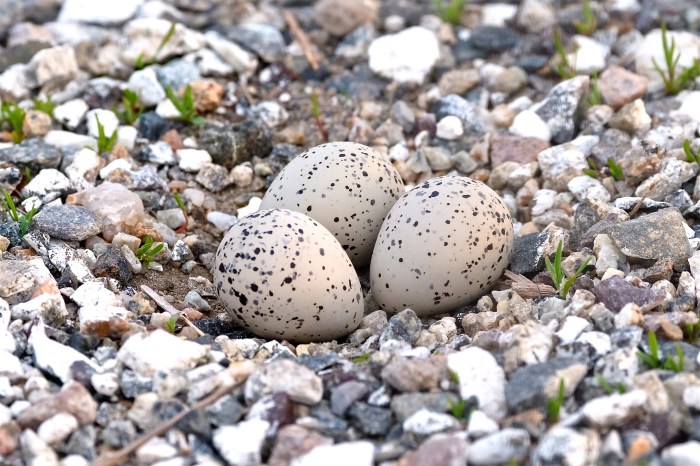 She begins laying eggs in the parking lot.
She begins laying eggs in the parking lot.
ANIMAL ADVISORY COMMITTEE MEETING TONIGHT
PIPING PLOVER SYMBOLIC FENCING RECOMMENDATIONS
ANIMAL ADVISORY COMMITTEE MEETING THURSDAY AUGUST 2ND AT 6:30PM AT CITY HALL: PIPING PLOVERS ON THE AGENDA.
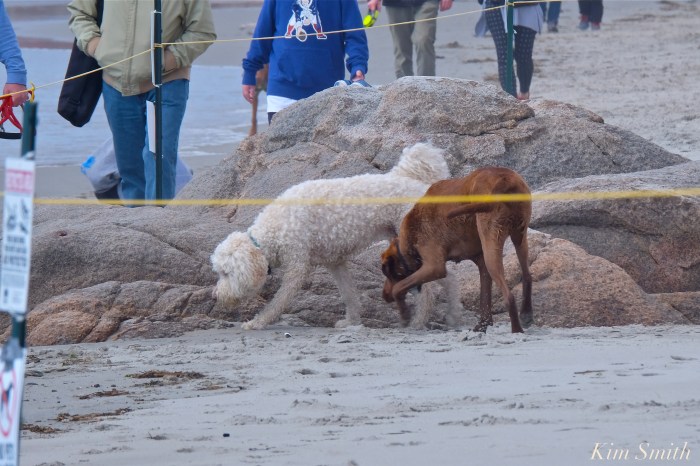 Dogs romping within the clearly posted and cordoned off nesting area in April, forcing the Piping Plovers off the beach and to nest in the parking lot.
Dogs romping within the clearly posted and cordoned off nesting area in April, forcing the Piping Plovers off the beach and to nest in the parking lot.
This past spring and summer we had a tremendously difficult time with our nesting bird symbolic fencing. The posted and roped off area is referred to as “symbolic” because it is not an actual physical barrier, but a visual warning to let people know to keep themselves and their pets out of the cordoned off area. People often ask, why can’t more permanent fencing be placed around the nesting area? After nearly thirty plus years of working with Piping Plovers, biologists have established that physical fences placed on the shoreline and in the wrack area are all too easily washed away with high tides, create safety issues and, too, you wouldn’t want to trap dogs and predators within a nesting area.
The difficulty with our metal posts is that they were knocked about and pushed down with nearly every high tide, dragging the roping into the sand as well. The rope and posts needed almost daily righting.
The Massachusetts Department of Conservation and Recreation (DCR), which successfully protects Piping Plovers and other endangered birds at dozens of Massachusetts beaches have come up with what appears to be a good fencing solution for areas within tidal zones. DCR uses long, narrow fiberglass rods which can be pushed easily into the sand. The poles are strung with two rungs of roping, and in some places three rungs. I measured the distances between the poles at Revere Beach; they are placed about every twenty to twenty four feet.
In early spring, before the Piping Plovers and Least Terns have nested, historic nesting areas are roped off. After a nesting pair establishes a territory, a second row of poles and roping are added around the perimeter of the nesting area. The fiberglass poles can be adjusted without too much difficulty.
Wooden poles are used to post the nondescript, but informative endangered species signs. According to DCR staff, the only time they have complications with the fencing is when the wooden posts are tied into the fiberglass poles and the tide takes both down.
I don’t understand why the fiberglass poles are less likely to shift in the tide, but they don’t shift and appear to work very well in the tidal zone–perhaps because they are flexible and less rigid. If anyone knows the answer to that, please write.
PIPING PLOVER VOLUNTEER MONITOR GOOD HARBOR BEACH NESTING AREA FENCING RECOMMENDATION:
- Symbolic fencing of the two historic Piping Plover nesting areas roped off between March 15th and April 1st (boardwalk #3 and boardwalk #1).
- Fiberglass poles placed every twenty feet to twenty four feet.
- One to two rungs of roping.
- Wooden posts with endangered species signs installed at the same time and in place by April 1st, but not attached to the fiberglass poles.
- When active nest scrapes are identified, adjust exisiting fencing, and add a second row of fencing around the perimeter.
- To the outer perimeter of fiberglass poles, use three rungs of orange roping attached to the poles, extending all around the perimeter. One rung at 12 inches above ground, one rung at about 24-30 inches above ground level, and the top rung at four feet above ground level.
- Piping Plover volunteers monitor fencing and adjust as needed.
 This photo, taken at Good Harbor Beach in early April, shows why it is so important to have the signs and roping in place by April 1st. People and dogs were playing in the nesting area while the PiPl were trying to nest. The top photo shows that a second, and even a third rung of roping, placed at dog height, may help to keep dogs out of the roped off area.
This photo, taken at Good Harbor Beach in early April, shows why it is so important to have the signs and roping in place by April 1st. People and dogs were playing in the nesting area while the PiPl were trying to nest. The top photo shows that a second, and even a third rung of roping, placed at dog height, may help to keep dogs out of the roped off area.
 Examples of symbolic fencing areas at Revere Beach and Nahant Beach. Notice the double row of fencing and the double and triple rungs.
Examples of symbolic fencing areas at Revere Beach and Nahant Beach. Notice the double row of fencing and the double and triple rungs.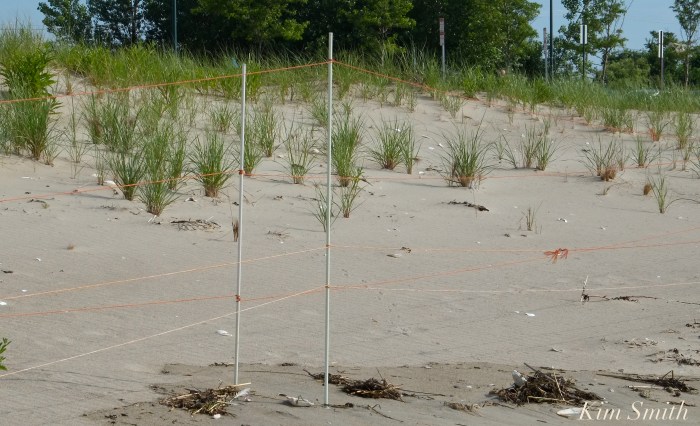
 Information is unambigulously posted at Revere Beach
Information is unambigulously posted at Revere Beach
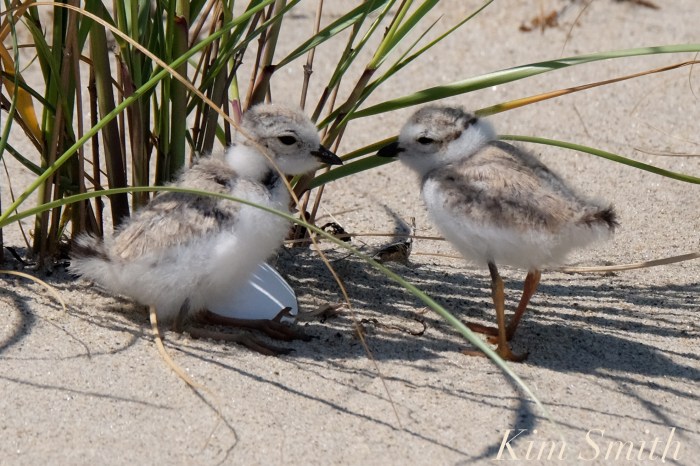 Piping Plover chicks finding shelter in the roped off nesting area on a hot summer day.
Piping Plover chicks finding shelter in the roped off nesting area on a hot summer day.
ANIMAL ADVISORY COMMITTEE MEETING THURSDAY AUGUST 2ND CITY HALL AT 6:30PM: PIPING PLOVERS ON THE AGENDA
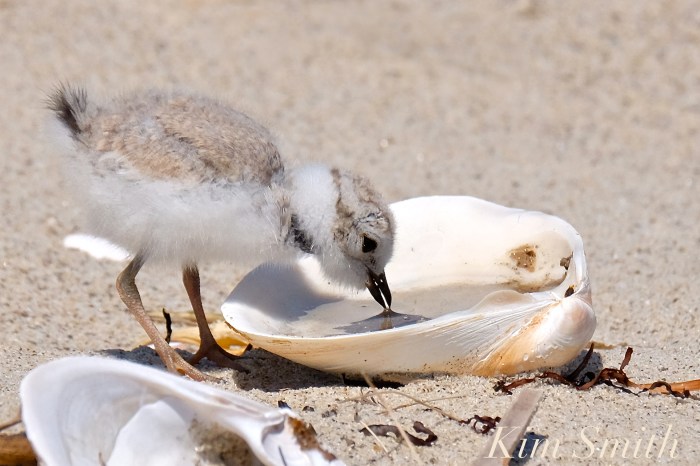 Please come and show your support for endangered and threatened shorebirds in Gloucester. Thank you!
Please come and show your support for endangered and threatened shorebirds in Gloucester. Thank you!
On the Agenda:
- Open session for public comments.
- Approval of meeting minutes from 7/12/18.
- Review of ACO reports and citations.
- Piping Plover protections: ordinance recommendations.
- Clark and First Parish Cemetery -dog walking.
- Event planning
- Grants
- Annual report
 The chicks of threatened birds such as Piping Plovers and Least Terns evolved to blend perfectly with their surrounding shoreline nesting habitat. This trait helps afford protection from hungry predatory birds flying overhead, birds such as hawks and owls. Because they are so well camouflaged, the shorebird nestlings are at great risk from fast moving pets and unknowing beach goers.
The chicks of threatened birds such as Piping Plovers and Least Terns evolved to blend perfectly with their surrounding shoreline nesting habitat. This trait helps afford protection from hungry predatory birds flying overhead, birds such as hawks and owls. Because they are so well camouflaged, the shorebird nestlings are at great risk from fast moving pets and unknowing beach goers.
PIPING PLOVER RECOMMENDATIONS TO THE MAYOR FROM THE PIPING PLOVER VOLUNTEER MONITORS ~
July 9, 2018
Dear Mayor Romeo Theken and Gloucester City Councilors,
We, the Piping Plover volunteer monitors, are submitting our short list of recommendations regarding the Piping Plovers nesting at Good Harbor Beach. Our goal is to have in place by next April 1, 2019, measures and ordinances that will greatly increase the likelihood that the hatchlings of this tiny threatened shorebird will have a fighting chance at surviving life on Good Harbor Beach.
Piping Plovers began nesting at Good Harbor Beach in 2016. Each year, the PiPl are coming earlier and earlier. In 2016, they arrived mid-May, in 2017 they arrived at the beginning of May, and this year, they arrived on April 3. It would appear that the same pair is returning to Good Harbor Beach, as the male marks his territory and attempts to build a nest scrape only several feet from the previous year’s nest (at Boardwalk #3 nesting area). More Plovers than ever were seen at Good Harbor Beach this spring, and if not for constant interruptions in the Boardwalk #1 nesting area, we would have had two pairs nesting on the beach.
Why are the birds arriving earlier and earlier? We can presume that the pair are more experienced travelers and that Good Harbor Beach is their “territory.” Does this mean we will eventually have dozens of pairs nesting on Good Harbor Beach? No, because the PiPl are very territorial and they will defend a fairly large area, preventing other PiPl from nesting in their site.
This year the PiPl pair hatched four chicks. All four chicks were killed by crows, gulls, and dogs. All three are human-created issues, and all three can be remedied. The following are the four recommendations and actions we wish to see take place.
Recommendations
1) Change the dog ordinance to not allow dogs on the beach after March 31.
Currently, dogs are allowed on the beach from October 1 to May 1. The Piping Plover volunteer monitor core group, Dave Rimmer from Greenbelt, Ken Whittaker, and Mass Wildlife’s John Regosin, all agree that dogs should not be allowed on Good Harbor Beach beginning April 1, but that it would be safe for Piping Plover fledglings and other migrating shorebirds for dogs to return after September 15.
This new suggested time frame will allow birds to nest on the beach (as opposed to in the parking lot), with far less interruption, shorebirds will nest earlier in the season, which will help with the chicks survival rate, and the chicks will be stronger by the time Good Harbor fills with summer crowds.
This is a very logical and simple solution. Disallowing dogs on Massachusetts coastal beaches where shorebirds are nesting, beginning April 1, is the norm. Allowing them to return after September 15, and in many cases after September 30, is also very common. For Piping Plovers and other nesting shorebirds, protecting their habitat and sharing the shore is a matter of life and death.
2) Rope off the nesting area by April 1.
Poles, with threatened species signs, and a triple row of roping of nesting sites, to be in place no later than April 1. Essex County Greenbelt’s Dave Rimmer will assist with this measure.
3) Enforce the existing ordinances regarding dogs (and littering) at all times throughout the year.
Only enforcing dog ordinances at Good Harbor Beach during nesting season is creating hostility toward the Piping Plovers.
Additionally, we do not recommend extremely high fines as we feel that may become an impediment to issuing and collecting the fines. We know of at least one example where the magistrate dismissed the tickets issued to a woman who claimed to have a service dog. This woman was running rampant on the beach and throughout dunes with her service dog off leash throughout the entire time the PiPl were nesting, from April through May. Despite the fact that former dog officer Diane Corliss caught the woman on camera with her dog off leash on the beach, and in the dunes, all her tickets that were issued by the animal control officer were dismissed. This is neither fair to the officers who are working hard to keep the dogs off the beach or to the plover volunteers who are spending inordinate amounts of time trying to keep the PiPl safe.
4). Increase trash collection.
When no barrels are placed at the entrances to the beach, people dump bags of trash there anyway. When barrels are in place, people put trash in the barrels however, when the barrels become full, they again resort to leaving bags of trash behind, only next to the barrels. In either scenario, gulls and crows are attracted to the trash. Both gulls and crows rip open the bags and the trash is blown throughout the parking lot and marsh, soon finding its way onto the beach and into the ocean. Hungry gulls and crows waiting for people to leave their trash behind eat tiny shorebirds.
A friend who lives on a North Carolina beach shares how her community keeps their public beaches looking pristine. Not only do they have barrels, but every few weeks, police patrol the beach and hand out fines for littering. This is taken as a wake up call, everyone is good for a bit of time, but then become slack about littering again. Out come the officers for another round of ticketing.
Thank you for taking the time to consider our recommendations.
Sincerely yours,
Kim Smith
cc Paul Lundberg, Steven LeBlanc, Val Gilmam, Ken Hecht, Melissa Cox, Jen Holmgren, Scott Memhard, Sean Nolan, Jamie O’Hara, Dave Rimmer, Ken Whitakker
42 PAIRS OF PIPING PLOVERS NESTING AT CRANES BEACH!
July 9th 2018 – From the Trustees “The Piping Plovers at Crane Beach are doing great this year! 42 pairs have nested making this the third highest amount of nesting Piping Plover pairs since 1986. So far 42 chicks have spread their wings and flown. Many more chicks are still on the beach and we are waiting on more nests to hatch. Please remember to keep your distance and give these protected birds their space.”
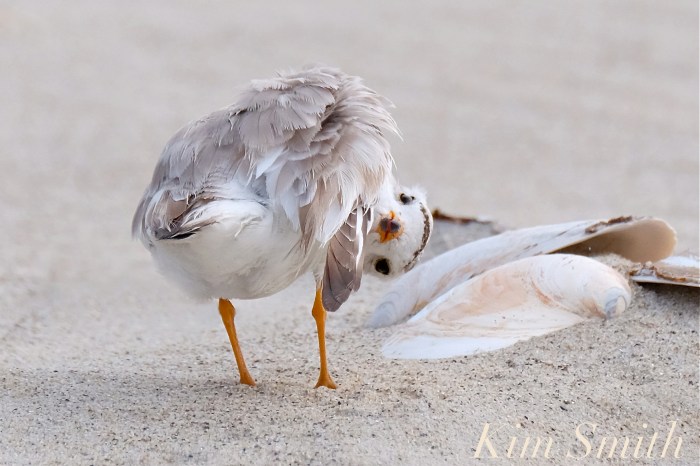 I love how the pale seashell coral pink in the clam shells mirrors the orange hues of the PiPl’s beak and legs. I don’t know why this photo strikes me as funny, but it just does. Tiny birds with huge personalities!
I love how the pale seashell coral pink in the clam shells mirrors the orange hues of the PiPl’s beak and legs. I don’t know why this photo strikes me as funny, but it just does. Tiny birds with huge personalities!
FOUR WAYS IN WHICH WE CAN HELP THE GOOD HARBOR BEACH PIPING PLOVERS SUCCESSFULLY FLEDGE CHICKS: OUR RECOMMENDATIONS TO THE MAYOR
Dear Readers,
Last Tuesday we sent our letter to Mayor Sefatia and the City Councilors with a short list of recommendations, based on the past three years of daily Piping Plover monitoring by myself and our core group of volunteer monitors. We purposefully kept the recommendations modest out of consideration to both the Piping Plovers and to our Good Harbor beach going community. Please find below the recommendations suggested by the Piping Plover volunteer monitors.
July 9, 2018
Dear Mayor Romeo Theken and Gloucester City Councilors,
We, the Piping Plover volunteer monitors, are submitting our short list of recommendations regarding the Piping Plovers nesting at Good Harbor Beach. Our goal is to have in place by next April 1, 2019, measures and ordinances that will greatly increase the likelihood that the hatchlings of this tiny threatened shorebird will have a fighting chance at surviving life on Good Harbor Beach.
Piping Plovers began nesting at Good Harbor Beach in 2016. Each year, the PiPl are coming earlier and earlier. In 2016, they arrived mid-May, in 2017 they arrived at the beginning of May, and this year, they arrived on April 3. It would appear that the same pair is returning to Good Harbor Beach, as the male marks his territory and attempts to build a nest scrape only several feet from the previous year’s nest (at Boardwalk #3 nesting area). More Plovers than ever were seen at Good Harbor Beach this spring, and if not for constant interruptions in the Boardwalk #1 nesting area, we would have had two pairs nesting on the beach.
Why are the birds arriving earlier and earlier? We can presume that the pair are more experienced travelers and that Good Harbor Beach is their “territory.” Does this mean we will eventually have dozens of pairs nesting on Good Harbor Beach? No, because the PiPl are very territorial and they will defend a fairly large area, preventing other PiPl from nesting in their site.
This year the PiPl pair hatched four chicks. All four chicks were killed by crows, gulls, and dogs. All three are human-created issues, and all three can be remedied. The following are the four recommendations and actions we wish to see take place.
Recommendations
1) Change the dog ordinance to not allow dogs on the beach after March 31.
Currently, dogs are allowed on the beach from October 1 to May 1. The Piping Plover volunteer monitor core group, Dave Rimmer from Greenbelt, Ken Whittaker, and Mass Wildlife’s John Regosin, all agree that dogs should not be allowed on Good Harbor Beach beginning April 1, but that it would be safe for Piping Plover fledglings and other migrating shorebirds for dogs to return after September 15.
This new suggested time frame will allow birds to nest on the beach (as opposed to in the parking lot), with far less interruption, shorebirds will nest earlier in the season, which will help with the chicks survival rate, and the chicks will be stronger by the time Good Harbor fills with summer crowds.
This is a very logical and simple solution. Disallowing dogs on Massachusetts coastal beaches where shorebirds are nesting, beginning April 1, is the norm. Allowing them to return after September 15, and in many cases after September 30, is also very common. For Piping Plovers and other nesting shorebirds, protecting their habitat and sharing the shore is a matter of life and death.
2) Rope off the nesting area by April 1.
Poles, with threatened species signs, and a triple row of roping of nesting sites, to be in place no later than April 1. Essex County Greenbelt’s Dave Rimmer will assist with this measure.
3) Enforce the existing ordinances regarding dogs (and littering) at all times throughout the year.
Only enforcing dog ordinances at Good Harbor Beach during nesting season is creating hostility toward the Piping Plovers.
Additionally, we do not recommend extremely high fines as we feel that may become an impediment to issuing and collecting the fines. We know of at least one example where the magistrate dismissed the tickets issued to a woman who claimed to have a service dog. This woman was running rampant on the beach and throughout dunes with her service dog off leash throughout the entire time the PiPl were nesting, from April through May. Despite the fact that former dog officer Diane Corliss caught the woman on camera with her dog off leash on the beach, and in the dunes, all her tickets that were issued by the animal control officer were dismissed. This is neither fair to the officers who are working hard to keep the dogs off the beach or to the plover volunteers who are spending inordinate amounts of time trying to keep the PiPl safe.
4). Increase trash collection.
When no barrels are placed at the entrances to the beach, people dump bags of trash there anyway. When barrels are in place, people put trash in the barrels however, when the barrels become full, they again resort to leaving bags of trash behind, only next to the barrels. In either scenario, gulls and crows are attracted to the trash. Both gulls and crows rip open the bags and the trash is blown throughout the parking lot and marsh, soon finding its way onto the beach and into the ocean. Hungry gulls and crows waiting for people to leave their trash behind eat tiny shorebirds.
A friend who lives on a North Carolina beach shares how her community keeps their public beaches looking pristine. Not only do they have barrels, but every few weeks, police patrol the beach and hand out fines for littering. This is taken as a wake up call, everyone is good for a bit of time, but then become slack about littering again. Out come the officers for another round of ticketing.
Thank you for taking the time to consider our recommendations.
Sincerely yours,
Kim Smith
cc Paul Lundberg, Steven LeBlanc, Val Gilmam, Ken Hecht, Melissa Cox, Jen Holmgren, Scott Memhard, Sean Nolan, Jamie O’Hara, Dave Rimmer, Ken Whitakker
REMINDER: ANIMAL ADVISORY COMMITTEE MEETING TONIGHT AT 6:30
PIPING PLOVERS ON THE ANIMAL ADVISORY COMMITTEE MEETING AGENDA THURSDAY NIGHT
PIPING PLOVER UPDATE – WHERE ARE THEY NOW?
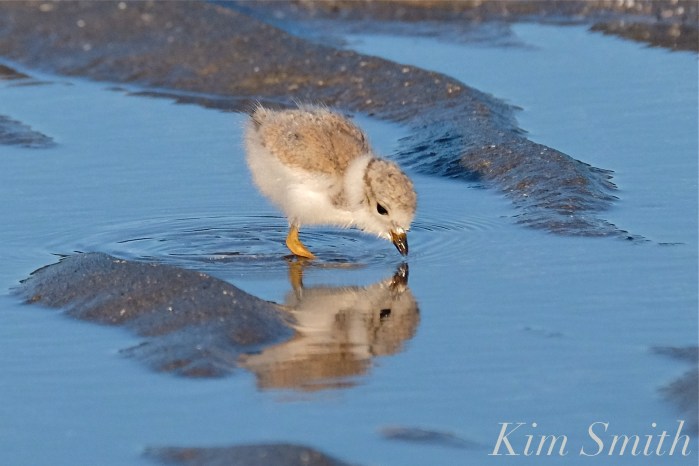 Pip, the day before he was killed.
Pip, the day before he was killed.
You may be asking, “where are the Good Harbor Beach Piping Plovers now?” Surprisingly, they are still around! After the night the last chick was killed (tracks point to a skirmish with a dog and several people in the nesting area), two Piping Plovers were reported at Cape Hedge Beach the following evening. Rockport resident Gail, who first reported the sighting, and PiPl volunteer monitor Laurie Sawin and I, found one at Cape Hedge the next morning, and by the next day, two had returned to the roped off area at #3 boardwalk!
Everyday since, either Greenbelt’s Dave McKinnon, my husband Tom, Deborah Cramer, or myself have spotted at least one in the cordoned off #3.
Recent PiPl sightings at the Good Harbor Beach nesting area.
Our thoughts are to leave some part of the roping up as long as the Piping Plovers are still using it as a sanctuary during high tide when the beach is crowded. For a second and even more important reason, many of us would like to see part of the cordoned off area stay in place for the simple reason it is helping with dune recovery.
You may recall that during late winter we had back to back nor’easters, which had a devastating effect on Good Harbor Beach in that much of the beach’s sand was washed away. The beach dropped about ten feet, which now causes the tide to come up high to the edge of the bluff. Beach grass and beach vegetation will help prevent future washouts. Because the area around #3 has been roped of since mid-April, a fantastic patch of beach grass has begun to take hold!!! If we leave a narrow strip roped off from the public, about ten to fifteen feet wide, running the length of the beach and around the creek bend, this simple step alone will have a marked impact on the overall health of the dune habitat.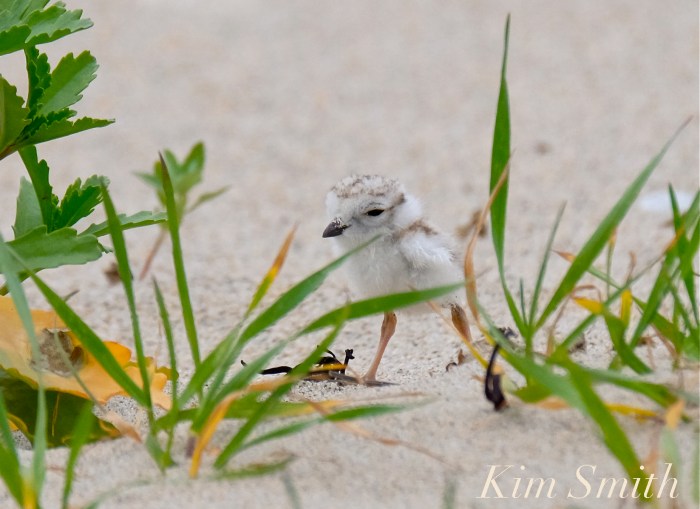 Beach plants help prevent erosion while also providing shade and shelter for tiny shorebirds.
Beach plants help prevent erosion while also providing shade and shelter for tiny shorebirds.
 A pair of one-day-old Least Tern chicks finding shade.
A pair of one-day-old Least Tern chicks finding shade.
OUR LITTLE PIP IS MISSING
 I am so very sorry to write that Little Pip and Mama went missing overnight.
I am so very sorry to write that Little Pip and Mama went missing overnight.
When super PiPl volunteer monitor Heather Hall left last night at 9:30 the beach was quiet and peaceful. The Plover Family had a good evening, despite the fact that a Burmese Mountain dog was off leash on the beach and the owners weren’t too happy about being asked to leave.
When I arrived at 4:50am, the beach was eerily quiet. Except for the gulls and crows, there were only the singular calls from Papa Plover. Back and forth he went, from feeding in the tide pools to running into the nesting area and piping for Mama and Pip.
A most heartfelt thank you to all our wonderful PiPl monitors, who are just the kindest people you will ever want to meet. Sunburns, neglected families, missing appointments, late for work–thank you for guarding our little PiPl family from sunrise to sunset. These dedicated volunteers fully understand what it means for a species to be threatened and on the brink of extinction. We all fell in love with our PiPls, it’s hard not to. If you see a volunteer, please stop and thank them for their good work. Please know too, that without their tireless dedication, we would not have known for sure how the other three chicks perished.
By understanding that the chick’s deaths are human-caused, whether it be garbage-attracting gulls and crows or dogs on the beach, we will be much, much better equipped next year to better help nesting shorebirds. It is my understanding that there was a bonfire and party at the rock last night, which I can imagine how terrified that must have made our PiPl family. We can only learn from these past incidents and are determined to make positive steps for the future. For example, imagine if Mama and Papa had been allowed to nest when and where originally intended. The chick would have been a full week older, with just that much more critical development to better adapt to situations such as warm weather night time beach partygoers.
Thank you and a huge shout out to Joe Lucido, Phil, Mike, Tommy, Kenny, Newt, Cindy, and the entire DPW crew. We know you were rooting for the PiPl family and your kind assistance made a difference at every turn.
Thank you to Gloucester’s conservation agent Ken Whittaker and to Essex Greenbelt’s Dave Rimmer. These two have been working together and behind the scenes since the PiPl first arrived on April 3rd, consulting with wildlife agencies, installing roping, installing the wire exclosure, coordinating the crazy monitor scheduling, and much more.
Big Hug and thank you to all our PiPl monitors and friends of the Piping Plovers who I know are just heartbroken tonight.
LITTLE PIP ZING ZANGING AROUND THE BEACH
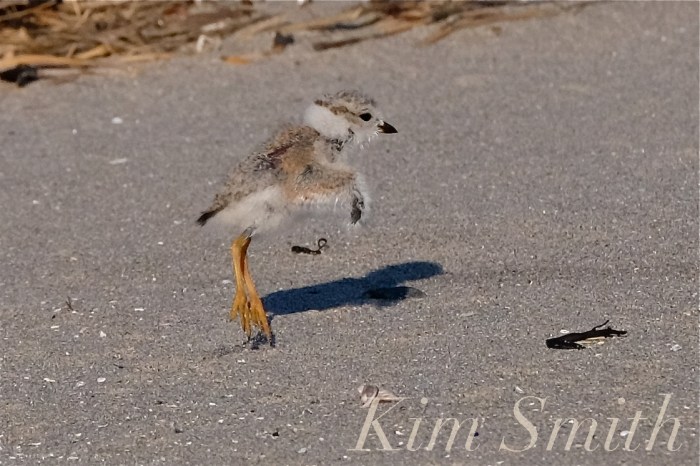 What are these things called wings?
What are these things called wings?
Pip grows rounder, stronger, and more capable of catching tiny sea creatures daily. We love watching the development of his wings especially. Soon his flying feathers will begin to grow. In the meanwhile, periodically throughout the day he does wonderfully zany-looking zing-zang-up-down-sideways-zig-zag mini flight tests throughout the day.
The Piping Plover’s soft sandy feather colors and patterns blend seamlessly with the surrounding beach habitat, but camouflage alone is not enough to keep the birds safe. The ability to fly to escape predatory danger is equally as important to Piping Plovers.
Massachusetts state wildlife biologists consider a Piping Plover fully fledged at 24 to 28 days, whereas federal wildlife biologists have determined a Piping Plover chick to be fully fledged at about 35 days. Judging from our observations of Little Chick last year, he did not fully fledge until five weeks old (35 days). He could manage brief sustained flight up to that time, but until he reached that five week milestone he was still at risk from predators, including and especially dogs and raptors.
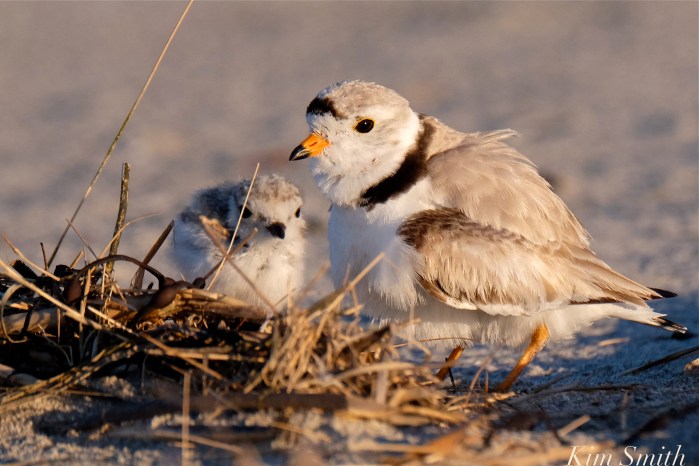
 Seventeen-day-old Pip needed lots of warming snuggles on this chilly Tuesday morning.
Seventeen-day-old Pip needed lots of warming snuggles on this chilly Tuesday morning.
HAPPY TWO-WEEK-OLD BIRTHDAY TO OUR LITTLE PIP!
 Our Good Harbor Beach Piping Plover Little Pip made the two-week-old milestone on Saturday!!!
Our Good Harbor Beach Piping Plover Little Pip made the two-week-old milestone on Saturday!!!
To survive two whole weeks is an important date for a Piping Plover chick. Pip’s chance of fledging has improved exponentially.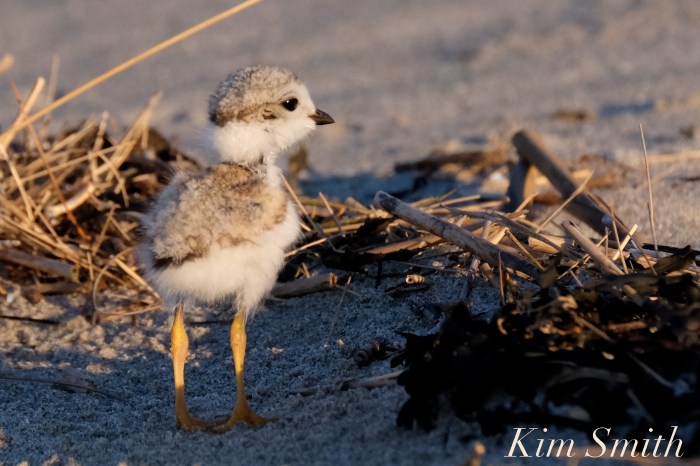
Every day he grows a little stronger, a bit taller and rounder, and noticeably faster. Less sleepy-eyed when waking up from snuggling under Mom or Dad, out he zooms from the warm wing of the parents like a jet-propelled rocket. And now he does this fascinating thing with his wings. Just as did Little Chick last year, at top speed, he zings and zangs with wings aflutter and aflap, seeming airborne for a few seconds. He won’t be able to sustain flight for another several weeks, but won’t it be marvelous when he does!
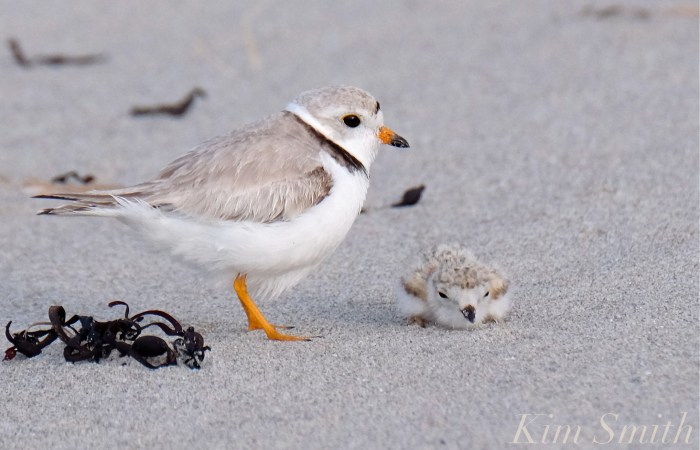 Piping Plover chicks and parents communicate with a wide range of piping calls. We are more likely to hear Mama and Papa’s shrill, urgent notes warning of pending danger. But more often, both chicks and parents communicate in soft, barely audible gentle notes. At about twelve days old, our Little Pip appeared to understand, and respond more quickly, to the piping calls of the parent’s commands. He now flattens level with the sand when Mama and Papa pipe danger notes, or when a predatory bird flies overhead.
Piping Plover chicks and parents communicate with a wide range of piping calls. We are more likely to hear Mama and Papa’s shrill, urgent notes warning of pending danger. But more often, both chicks and parents communicate in soft, barely audible gentle notes. At about twelve days old, our Little Pip appeared to understand, and respond more quickly, to the piping calls of the parent’s commands. He now flattens level with the sand when Mama and Papa pipe danger notes, or when a predatory bird flies overhead.
Dip-diving in the tide pools for breakfast!
This insect was so large, from a distance I at first thought Pip was eating seaweed. He swallowed the bug in one gulp!
Pip continues to snuggle under wing, but will do so less and less frequently as he develops and is better able to thermoregulate. I recall our Little Chick last summer attempting to snuggle under Papa Plover even at thirty-days-old, which by the way, looked terribly silly, but sweet, to see a chick nearly as large as the parent try to snuggle under its wing.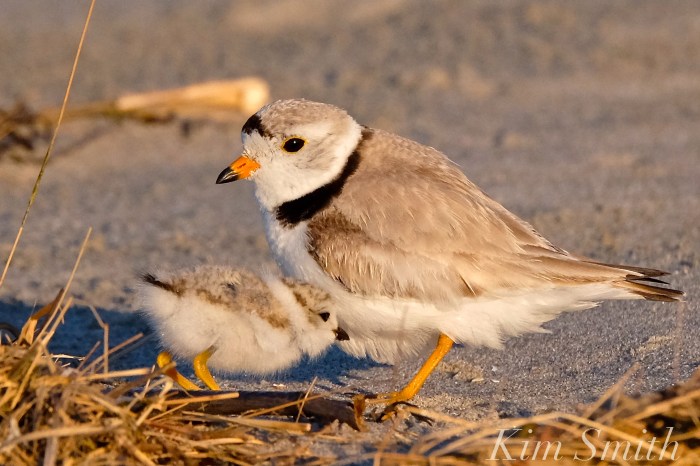
* * *
Two weeks ago Saturday, our lone surviving chick hatched in the parking lot at Good Harbor Beach. Despite being driven off the beach by dogs running through the nesting area (sadly finding the lot to be the least dangerous place to nest), Mama and Papa PiPl successfully hatched four chicks from four eggs. This would not have been possible without a whole lot of help from Gloucester’s DPW, Essex County Greenbelt’s Dave Rimmer, Gloucester’s conservation agent Ken Whittaker, and a core group of super dedicated volunteers.
After spending the first day in the parking lot, the family of six–Mama, Papa, and four one-day-old chicks made the epic journey across the width of the parking lot, through the landscape of tall dune grass, tumbling down the steep slope of the dune, and into the roped off nesting area. Had Papa and Mama pre-planned this route? I think yes.
Life for a Piping Plover chick, especially at Gloucester’s most well-loved and highly trafficked of beaches, is impossibly tough. The first chick to perish was eaten by a gull, the second was taken out by a dog off leash in the nesting area, and the third, by a crow. In one way or another, the trail as to why these tender little shorebirds perished leads to the heavy footprint left by people.
Morning meet and greet of the Crow Breakfast Club, held every day on Nautilus Road following a warm sunny beach day.
Same for the Seagull Breakfast Club
Gloucester does not have a seagull and crow problem, but we do have a littering, as well as a lack of trash barrels problem. If the crows and gulls were not finding the mounds of trash littering the beach, and piled at the entryways to the beach, each and every single morning, they would simply find somewhere else to forage. Bright and early, every morning the DPW crews arrive to clean the beach, but what happens before they arrive? For the first three hours of daylight, the crows and gulls devour a smorgasbord of tantalizing treats, feasting on loose garbage strewn the entire length of the beach, in the parking lot, and at all the entrances to the beach. Forget placing the garbage in bags if the bags are not contained in barrels; the birds, rats, and coyotes knowingly rip right through them. The plastic cups, bottles, to-go containers, and accoutrements blow freely through the dunes and marsh and eventually, all is carried into the ocean.
The trash problem holds true throughout the city. If folks stopped feeding the crows and gulls, and we solve the garbage problem, we will rid ourselves of ninety percent of the issues surrounding gulls, crows, coyotes, and rats. Carry in, carry out works to a degree, but barrels are sorely needed at locations such as the entrance to the footbridge. Additionally, residents would ideally place their garbage, in barrels, the morning of trash collection (as opposed the the night before), dumpsters always kept tightly covered, and littering laws strictly enforced.
A friend from North Carolina shared that the beaches in her community are pristine. How do you do it I asked? Two simple solutions. Number one is barrels and number two is enforcing littering laws. Every few weeks, police patrol the beaches and hand out fines for littering. After a few weeks or so, people become lax about littering, and out come the police handing out another round of fines. Would this be a money-maker for the City of Gloucester I wonder?
 Plastic glistening in the morning sun – Good Harbor Beach, before the DPW arrives.
Plastic glistening in the morning sun – Good Harbor Beach, before the DPW arrives.
Dogs off leash at Good Harbor Beach continue to frustrate us all. Despite stepped up enforcement, local residents and out-of-towners continue to flaunt the rules and the No Dogs signs. Every single day, we monitors see dog owners with their dogs, and dog tracks, at Good Harbor Beach.
Dune fencing, which is slated to be replaced after the Piping Plovers leave, is going to help to keep the dogs (and people) out of the dunes. I hope well placed signs that speak to the fragility of the dunes will also accompany the new fencing. If you can imagine, people allow their dogs to run freely through the dunes and also use the dunes as their personal bathroom. Sometimes the scofflaws don’t even bother to climb the dunes, but run right through the nesting area and stand in broad daylight at the base of the dunes, in full view of all, to relieve themselves.
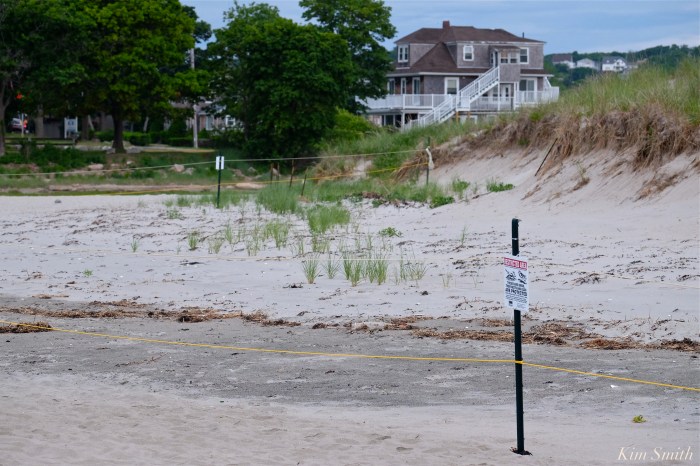 Note the beach grass growing at the base of the dunes where the roping has been in place since mid-April. I hope this area continues to be roped off, even after the PiPls depart. Growing sturdy patches of dune grass will help tremendously with the ever increasing problem of beach erosion.
Note the beach grass growing at the base of the dunes where the roping has been in place since mid-April. I hope this area continues to be roped off, even after the PiPls depart. Growing sturdy patches of dune grass will help tremendously with the ever increasing problem of beach erosion.
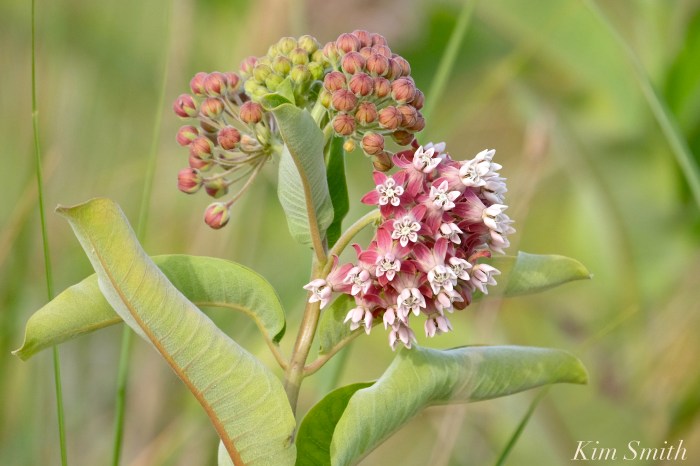 Common Milkweed (Asclepias syriaca) is coming into bloom at the Good Harbor Beach dunes. The many species of wildflowers found growing in the dunes provides myriad species of wildlife with both food and shelter.
Common Milkweed (Asclepias syriaca) is coming into bloom at the Good Harbor Beach dunes. The many species of wildflowers found growing in the dunes provides myriad species of wildlife with both food and shelter.
 Fifteen-Day-Old Piping Plover Chick and Mama
Fifteen-Day-Old Piping Plover Chick and Mama
WHAT DO PIPING PLOVERS EAT?
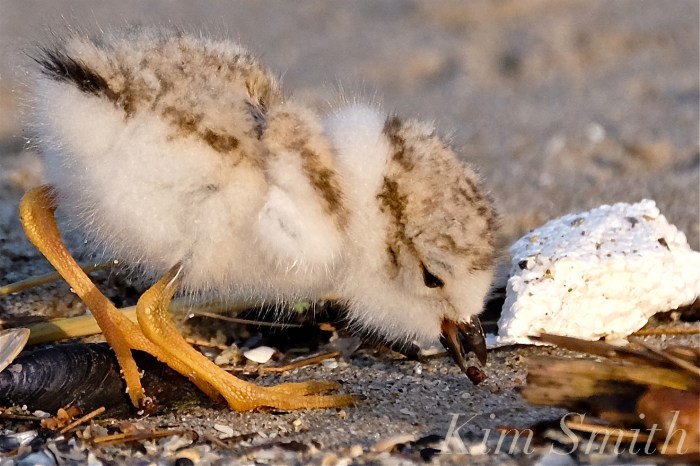 “What do Piping Plovers eat, especially the chicks?” is one of the questions most frequently asked of our volunteer monitors.
“What do Piping Plovers eat, especially the chicks?” is one of the questions most frequently asked of our volunteer monitors.
Piping Plover chicks eat everything the adults eat, only in smaller bites, and pretty much anything they can catch. We’ll often see the chicks pecking repeatedly in one spot. Unlike Mama and Papa PiPl, they don’t always eat the insect in one swallow. The chick will chase after the insect and eat it in several beakfulls.
Piping Plovers forage at the shoreline, in the intertidal zone, and at mud and sand flats. While running, they scan the immediate area, and then peck at the prey it locates. When by the water’s edge and in the sand flats, they eat sea worms, tiny crustaceans, and mollusks. When around the wrack line, they find teeny insects including spiders, beetles, ants, and insect larvae.
 Here’s our little Pip at eight days old feeding on a winged insect. Piping Plover chicks begin pecking and looking for food within hours after hatching.
Here’s our little Pip at eight days old feeding on a winged insect. Piping Plover chicks begin pecking and looking for food within hours after hatching.
If you would like to be a Piping Plover volunteer monitor, please contact kwhittaker@gloucester-ma.gov. Thank you, and the PiPl thank you, too 🙂
SHOUT OUT TO GLOUCESTER’S ANIMAL CONTROL OFFICER JAMIE LEVIE
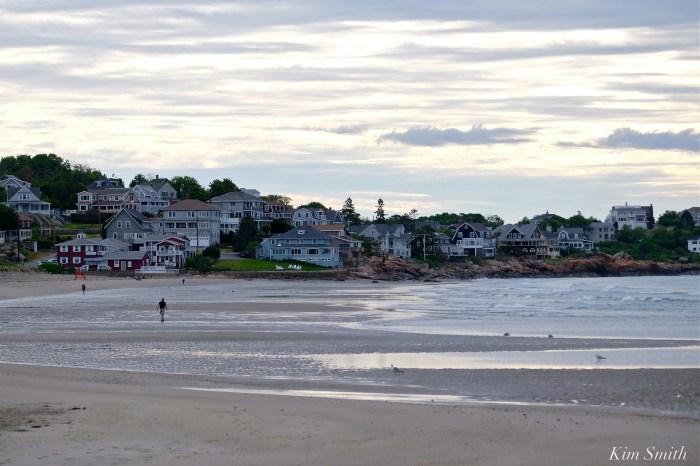 How terrific to see Officer Jamie Levie at Good Harbor Beach bright and early this morning- and a quiet peaceful morning it was. Officer Teagan Dolan was at GHB yesterday morning, too. Our sincerest thanks to ACOs Jamie and Teagan, and to Chief John McCarthy for the stepped up patrols at Good Harbor Beach and for all their kind assistance with our GHB PiPl family.
How terrific to see Officer Jamie Levie at Good Harbor Beach bright and early this morning- and a quiet peaceful morning it was. Officer Teagan Dolan was at GHB yesterday morning, too. Our sincerest thanks to ACOs Jamie and Teagan, and to Chief John McCarthy for the stepped up patrols at Good Harbor Beach and for all their kind assistance with our GHB PiPl family.
DEBUNKING PIPING PLOVER MYTH #5: PIPING PLOVER HELPERS ARE NOT CALLING FOR AN OUTRIGHT BAN OF DOGS ON THE BEACH
Despite the extremely inflammatory posts you may have been reading elsewhere, the Piping Plover volunteer monitors and local wildlife experts are not in any way, shape, or form promoting the permanent ban of dogs from Good Harbor Beach.
Currently, dogs are not allowed on the beach from May 1st to September 30th. The PiPl volunteer monitor core group, Dave Rimmer from Greenbelt, Ken Whittaker, who is Gloucester’s conservation agent, and Mass Wildlife’s John Regosin all agree that dogs should not be allowed on Good Harbor Beach beginning April 1st, but that it would be safe for Piping Plover fledglings and other migrating shorebirds for dogs to return after September 15th.
This new suggested time frame will allow birds to nest with far less interruption, shorebirds will nest earlier in the season (which will help with the chicks survival rate), and the chicks will be stronger by the time Good Harbor fills with summer crowds. This is a very logical and simple solution. Disallowing dogs on Massachusetts coastal beaches where shorebirds are nesting, beginning April 1st, is quite common. Allowing them to return after September 15, and in many cases after September 30th, is also very common. For Piping Plovers and other nesting shorebirds, protecting their habitat and sharing the shore is a matter of life and death.
To be very, very clear, we Piping Plover volunteers do not wish to permanently and forever ban dogs off Good Harbor Beach, or any Gloucester beaches.
Please email or call Mayor Sefatia’s office and your City Councilors and let them know your thoughts about Piping Plovers, dogs, and all the wildlife that finds a home at Good Harbor Beach. We hope you agree that making this simple change in the ordinance from April 1st to September 15th is the best solution for all our wild and domestic creatures. This modification to the dog ordinance will also show the federal agents that the Gloucester community recognizes our responsibility and takes very seriously our commitment to protecting endangered and threatened species.
Thank you.
Mayor Sefatia Romeo Theken: sromeotheken@gloucester-ma.gov, 978-281-9700
Councillors At Large
Paul Lundberg, President: plundberg@gloucester-ma.gov, 978-282-8871
Melissa Cox: mcox@gloucester-ma.gov, 978-631-9015
Jamie O’Hara: johara@gloucester-ma.gov, 978-979-7533
Jen Holmgren: jholmgren@gloucester-ma.gov, 978-335-4748
Ward 1 Councilor Scott Memhard: smemhard@gloucester-ma.gov, 978-283-1955
Ward II Councillor Ken Hecht: khecht@gloucester-ma.gov, 617,755-9400
Ward III Councillor and Vice-president Steven LeBlanc: sleblanc@gloucester-ma.gov, 978-283-3360
Ward IV Valerie Gilman: vgilman@gloucester-ma.gov, 978-621-4682
Ward V Councillor Sean Nolan: snolan@gloucester-ma.gov, 978-375-8381
If you would like to be a Piping Plover volunteer monitor, please contact Ken Whittaker at kwhittaker@gloucester-ma.gov.
* * *
HAPPY FATHER’S DAY! BROUGHT TO YOU BY PAPA PLOVER
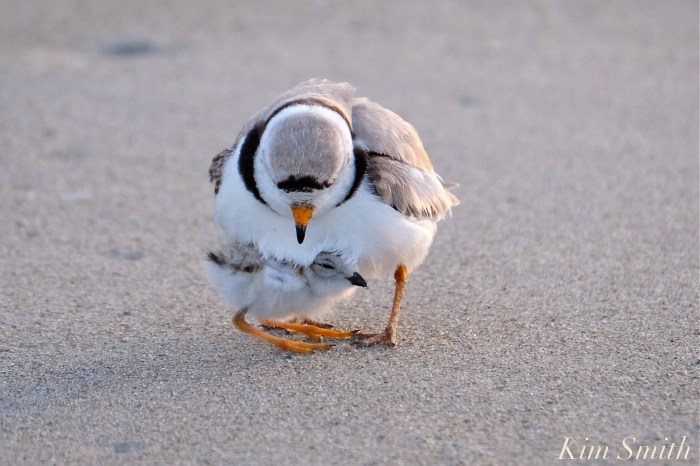 Papa and Pip snuggling today
Papa and Pip snuggling today
Whenever folks stop by to ask questions at the nesting area and they see the little chicks snuggling under the adult PiPl, they almost automatically assume it is the Mama Plover. Half the time it is the female, and the other half, the male. Mom and Dad share equally in caring for the chicks, generally in twenty minute to half hour intervals. They are always within ear shot and while one is minding the chicks, the other is either feeding itself, grooming, or patrolling for predators. Last year, as is often the case, the Mama Plover departed Good Harbor Beach several weeks before the chick fledged, leaving Little Chick entirely under Papa’s care.
Eight-Day-Old Little Pip
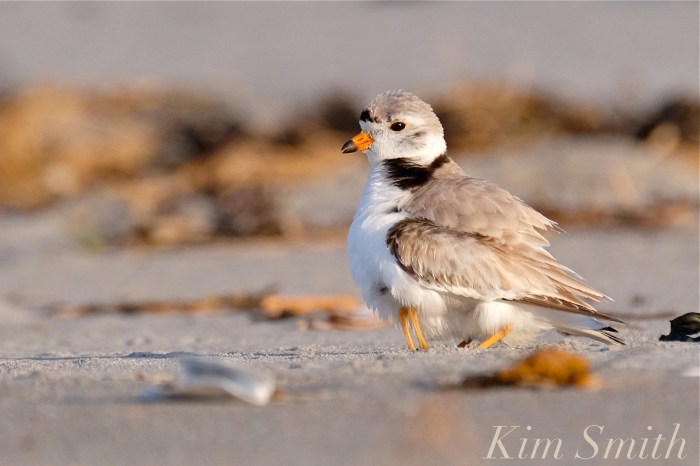 Papa piping a warning call to Mama, while snuggling Pip
Papa piping a warning call to Mama, while snuggling Pip 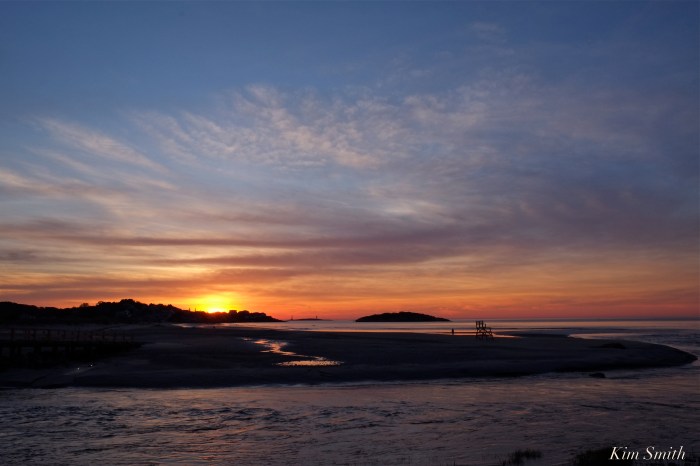
If you would like to help monitor Pip and our PiPl family, please contact Ken Whittaker at kwhittaler-ma.gov.
OUR THIRD GOOD HARBOR BEACH PIPING PLOVER CHICK WAS KILLED THIS MORNING
 We are so very sorry to share that the third chick was killed this morning. The seven-day-old chick was taken and eaten by a very large crow that swooped in unexpectedly, as witnessed by the volunteer monitors.
We are so very sorry to share that the third chick was killed this morning. The seven-day-old chick was taken and eaten by a very large crow that swooped in unexpectedly, as witnessed by the volunteer monitors.
One week ago today all four Good Harbor Beach Piping Plovers hatched in the parking lot. We celebrated, but also knew that the really hard part was yet to come. Monitoring tiny marshmallow sized fluff balls, made the color of their surroundings, is like looking for sand upon sand. To do this several hours at a time is no small feat, made even more challenging on Gloucester’s busiest of beaches.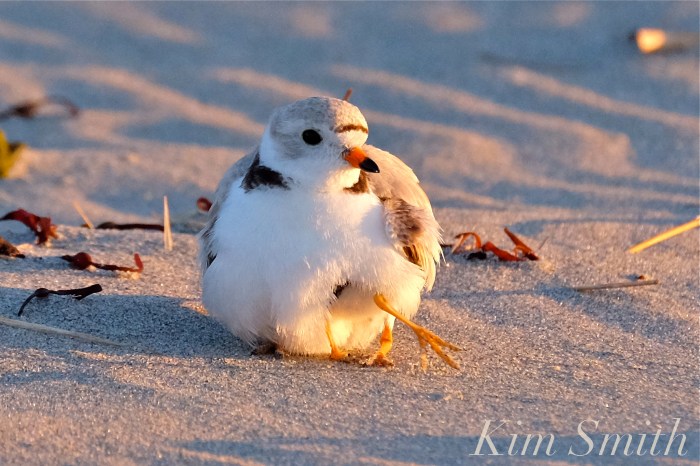
I would like to give a huge shout out and thank you to all our super dedicated PiPl monitors. Know that they are doing the very best they can to fend off predators of every kind, ill mannered people, astronomically high tides, diminished beach, people who have been drinking in the hot sun all day, garbage left behind on the beach (which attracts crows and gulls), and every other creepy thing you can think of. The core group is putting in many hours, are sunburnt, and neglecting their families.
A terrible mishap of death or injury to a chick could happen on anyone of our shifts. When you see a PiPl monitor at GHB, stop and feel free to ask questions about the plovers, and please thank them for their dedication. I honestly hope I don’t see one more facebook post/comment blaming the monitors about how we are not doing enough to keep the chicks safe and not reporting enough about the scofflaws. It is just plain cruel. Thank you.
Our one remaining chick, the one volunteer monitor Heather Hall calls Pip, is the smallest of the hatchlings and the one we think hatched last. This afternoon Mom was keeping watchful eye while Pip was foraging between the foot of the dunes and line of folks at the rope’s edge.
Early this morning when we still had both chicks.
SHOUT OUT TO GLOUCESTER’S ANIMAL CONTROL OFFICERS TEAGAN AND JAMIE!
 Gloucester’s Animal Control Officers Teagan and Jamie were on the scene at the crack of dawn at 4:30 this morning fixing the posts around the PiPl nesting area and writing tickets. Last night Jamie was on the beach as well. Thank you Jamie, Teagan, and Chief McCarthy for the stepped up patrolling.
Gloucester’s Animal Control Officers Teagan and Jamie were on the scene at the crack of dawn at 4:30 this morning fixing the posts around the PiPl nesting area and writing tickets. Last night Jamie was on the beach as well. Thank you Jamie, Teagan, and Chief McCarthy for the stepped up patrolling.
 The posts needed to be pulled out of the sand because last night we had yet another super high tide, all the way up to the bluff for most of the length of the beach.
The posts needed to be pulled out of the sand because last night we had yet another super high tide, all the way up to the bluff for most of the length of the beach.
I read a comment yesterday that stated falsely that the animal control officers make $80,000.00 a year and sit around and drink coffee all day. I have it on good authority that their combined incomes do not total $80,000.00 a year. Stating misinformation and disparaging the hard working people in our community is creating a false narrative and is hurtful to everyone involved, to the people, the dog owners, and to the shorebirds.
 Teagan and Jamie writing tickets at dawn this morning.
Teagan and Jamie writing tickets at dawn this morning.
We don’t have as much an enforcement problem as we do an issue with entitlement and ignorance. Ignorance in the sense that scofflaws may be from out of town and may be unable to read, and entitlement in that some people know the rules and know the dangers that dogs pose to the shorebirds, yet choose to do as they please.
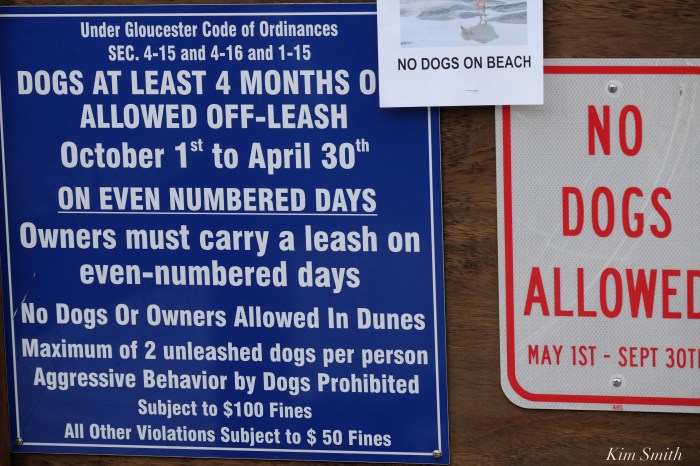 Upon entering Good Harbor Beach this morning, the scofflaws with their dog walked by these three signs.
Upon entering Good Harbor Beach this morning, the scofflaws with their dog walked by these three signs.
Walking a dog on a beach is a purely recreational activity. For teeny tiny nesting shorebird chicks, protecting that same beach habitat is a matter of life and death.
If you see a dog at anytime or anywhere on Good Harbor Beach, please call this number: 978-281-9900.
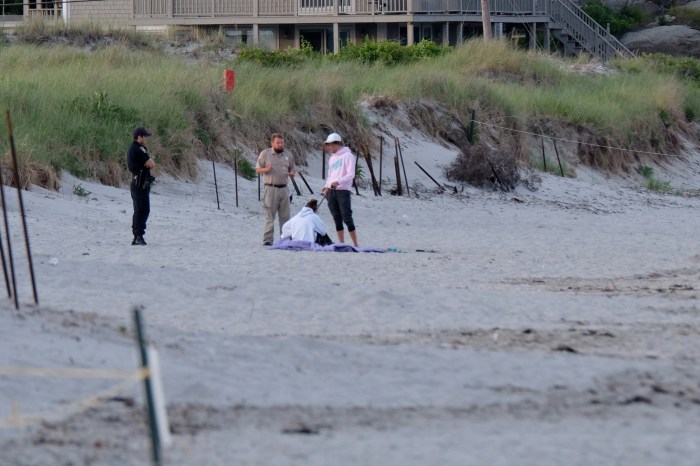 As of late, it appears as though many more people now have the need of a service dog. Having a service dog requires that it be on leash at all times, not jumping on people, and not running through the dunes. Service dogs cannot go in the dunes, or anywhere on the beach that is restricted to humans.
As of late, it appears as though many more people now have the need of a service dog. Having a service dog requires that it be on leash at all times, not jumping on people, and not running through the dunes. Service dogs cannot go in the dunes, or anywhere on the beach that is restricted to humans.
Would the people with service dogs consider taking their dog to any other of Cape Ann’s stunning beaches, rather than to Good Harbor Beach during shorebird nesting season I wonder? 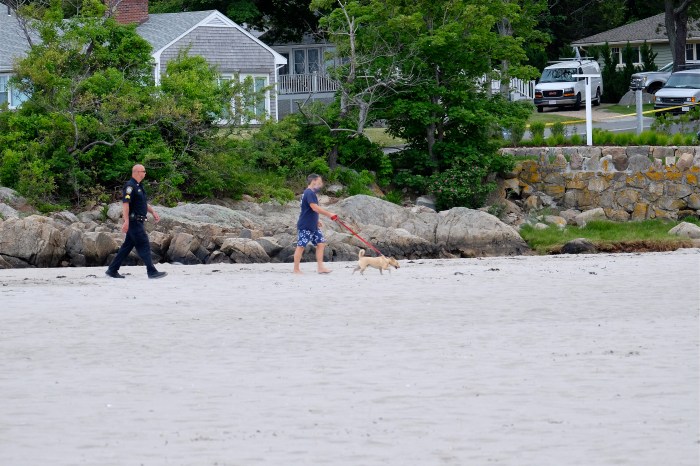
Folks getting ticketed and escorted off the beach.
Truly, the most important action people can take is to volunteer to help watch over the chicks. We have a number of folks posing as helpers but sadly, they are not actually volunteering for shifts. Two monitors on each shift would be ideal, but this year we have fewer volunteers, and don’t even have single person coverage during large chunks of time. Keeping watch over the baby birds will make a difference in whether or not the chicks survive. Anyone can be a volunteer and anyone of us can show you what to do. Finding people to help has been especially difficult on the weekends. Please contact kwhittaker@gloucester-ma.gov if you would like to lend a hand. Thank you so very much ![]()
 Six-day-old Piping Plover Chick
Six-day-old Piping Plover Chick
 This morning’s dog tracks at Good Harbor Beach – Dog tracks are easy to spot and to differentiate from other canids (fox and coyote). For example, notice the sharp toenail indentation. Coyotes have rounded toe tip prints because they wear their nails down.
This morning’s dog tracks at Good Harbor Beach – Dog tracks are easy to spot and to differentiate from other canids (fox and coyote). For example, notice the sharp toenail indentation. Coyotes have rounded toe tip prints because they wear their nails down.
Dog tracks Good Harbor Beach
Look what other tracks were spied this week, deer! These too are easy to spot in the sand. The deer’s cloven hoof makes a broken heart shape. White-tailed Deer Tracks Good Harbor Beach
White-tailed Deer Tracks Good Harbor Beach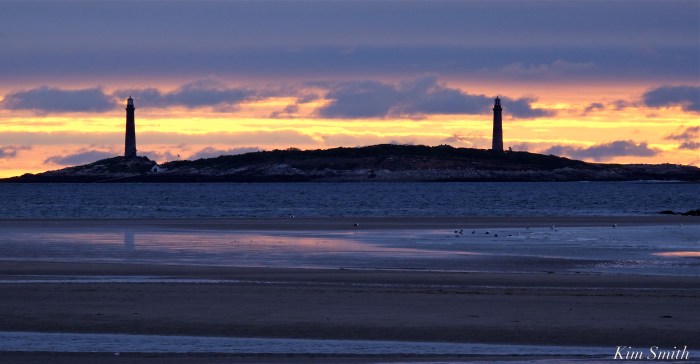
Today’s early morning Good Harbor Beach view of Thacher Island Twin Lights
THANK YOU GLOUCESTER VOLLEY BALL PLAYERS FOR KEEPING GOOD HARBOR BEACH SO CLEAN!
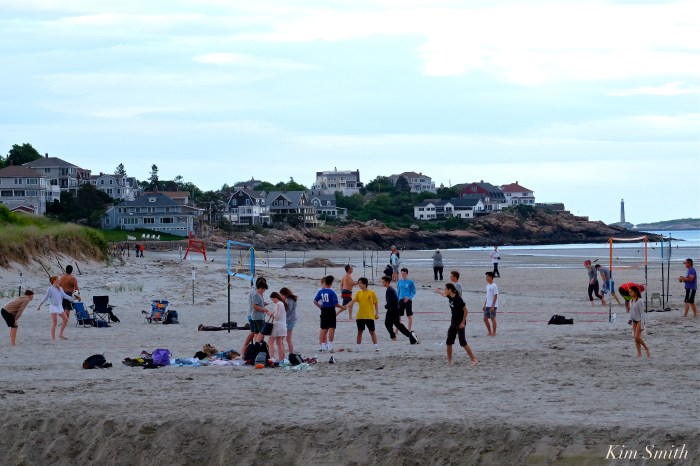 Last night the GHB volleyball players group appeared to be larger than usual yet, despite that, there wasn’t an ounce of trash left on the beach. Typically what happens after a large group gathering on the beach is that the gulls descend en masse, eating and dragging all over the beach the food and garbage that is left behind. It becomes particularly difficult for the PiPl parents to keep the chicks safe from the hovering and deadly dangerous gulls and crows. Keeping the beach clean helps tremendously in keeping the gulls away. Thank you!
Last night the GHB volleyball players group appeared to be larger than usual yet, despite that, there wasn’t an ounce of trash left on the beach. Typically what happens after a large group gathering on the beach is that the gulls descend en masse, eating and dragging all over the beach the food and garbage that is left behind. It becomes particularly difficult for the PiPl parents to keep the chicks safe from the hovering and deadly dangerous gulls and crows. Keeping the beach clean helps tremendously in keeping the gulls away. Thank you!
